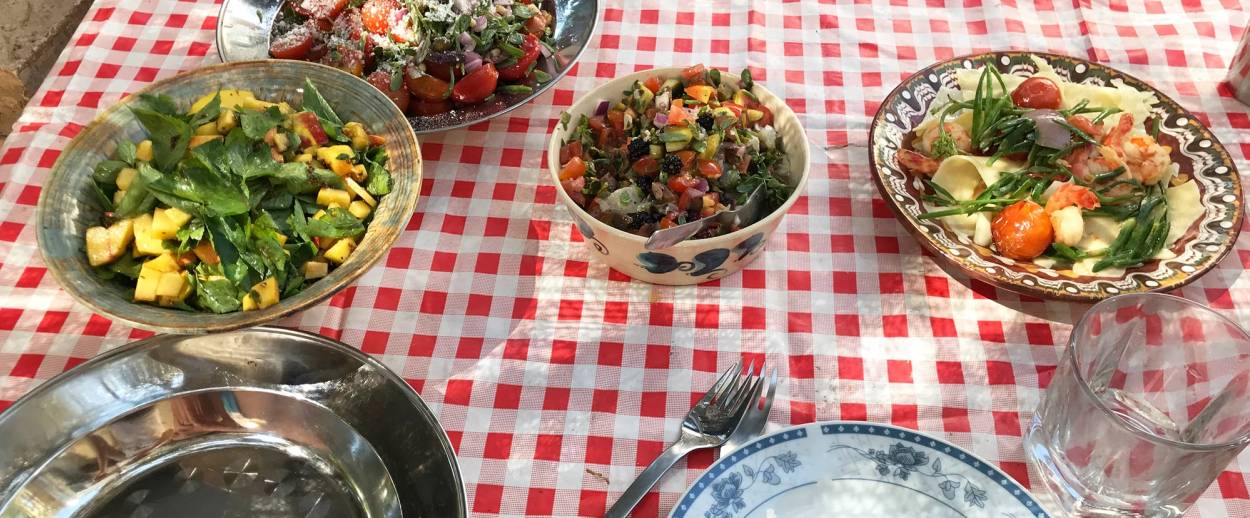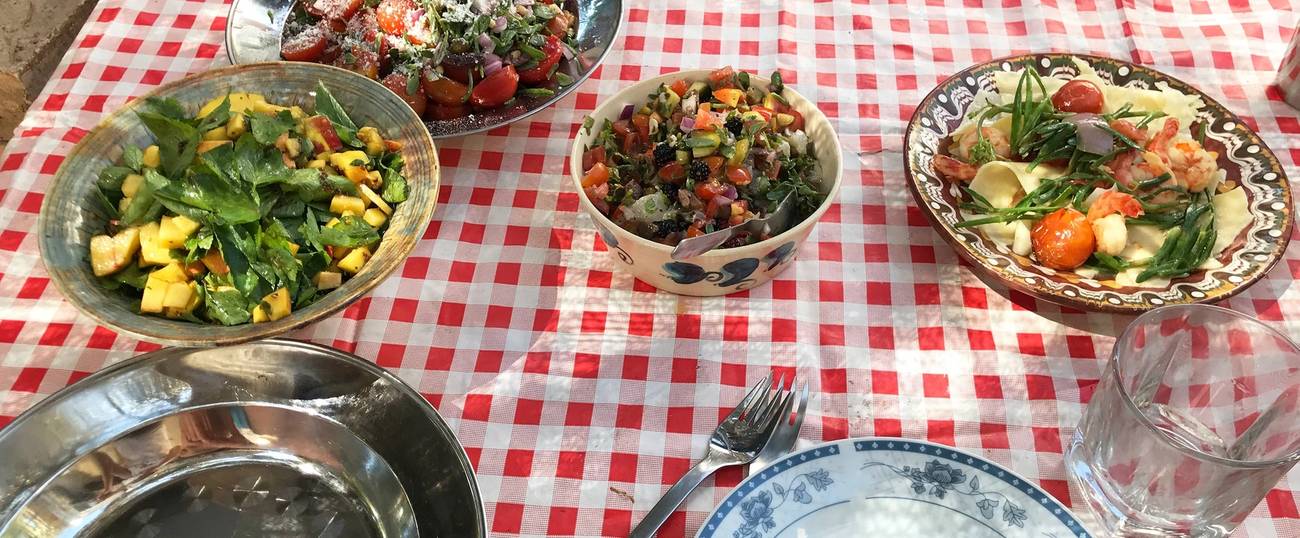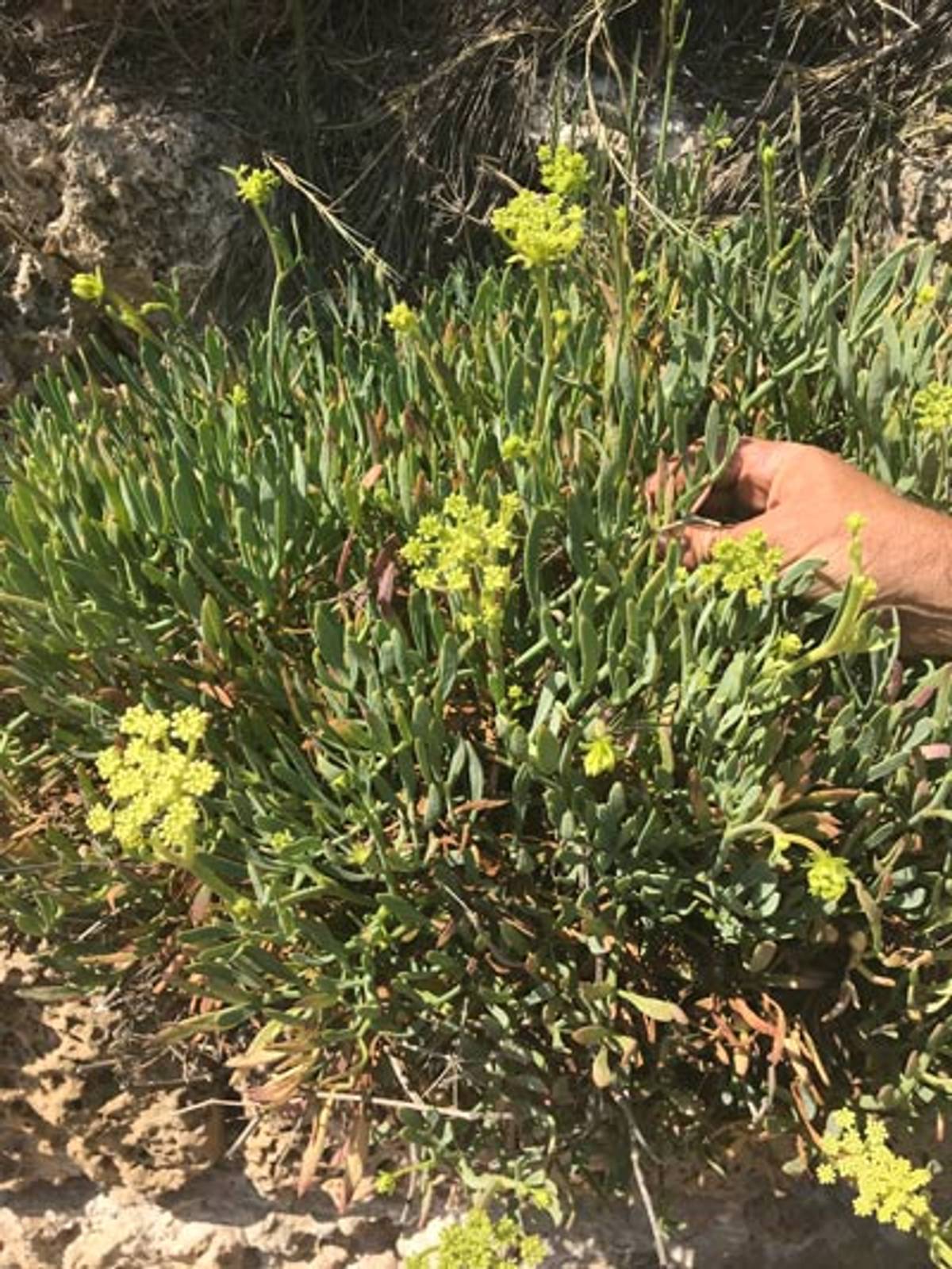Seaside Dining
Sea foraging for plants that grow along the shore has become a growing—and delicious—trend in Israel




Everybody knows you can go to the beach in Israel to swim, suntan, read a sandy newspaper, and build a sandcastle with your kids. Not many know, though, that you can find bushes of delicious plants right on the shore and pick them for your dinner. Lately, sea foraging for plant life along Israel’s Mediterranean coast has become a practice that more people are becoming aware of, as part of the ever-growing locavore food movement.
Even though sea plants grow along the entire coast of Israel, most of the country’s sea foraging is done along Israel’s Northern Coastal Plains—between Netanya and Haifa. “You just have to know where to look,” expert forager Yatir Sade told me. Sade is the founder of Shirat Hasade, an Israeli gathering and foraging organization that organizes food-collecting workshops and tours. One of his tours is dedicated to sea foraging, which results in bags full of delicious, mysterious, and very healthy plants most of us have never heard of. Most of them can be eaten raw, pickled, or cooked. Some grow only in certain months; others grow all year long.
Along Israel’s shores you can find sea rocket/arugula, a leaf that packs a punch of bitterness and salinity and is rich in iron and vitamin C. Crithmum, which is also known as rock samphire or sea fennel, can be found not only in the Mediterranean, but also on the coasts of Britain. The Mediterranean saltbush is known in Hebrew as maluaḥ, meaning “salty.” Saltbush has been eaten since the Stone Age and the Mediterranean version was mentioned as food in the Bible and in the Mishna. It can easily be gathered in Israel since it grows both in drought and in saline soils. Its leaves retain salt, which gives it its special flavor. And there is the ice plant, which is covered with glistening bladder cells or water vesicles that look like ice—hence the name. It is rich in protein and contains antioxidants that can lower cholesterol and may reduce allergy symptoms.
“Plants that grow near the sea have to cope with an extremely complex and difficult environment,” Sade told me. “They have to cope with high radiation, high saltiness, extreme temperature changes between the night and day, strong winds, sea spray, and lots of sand. These plants need to adapt to these difficult conditions, which makes them very durable. Some of them even depend on a lot of sun and salt, and some of them also grow in the desert.”
When I asked if these plants are similar to seaweed, Sade seemed appalled. “No! They are nothing like seaweed!” he said. “Seaweed is algae. These are real plants with flowers and seeds. Some of them, like the ice plant, Crithmum, and Salicornia, are succulents. The fact that these plants grow next to the sea affects their texture and taste. They are juicy, crispy, and salty. They are meaty because this lets them dilute the salt that is in the soil with a lot of water so that the salt doesn’t dry them out.”

Traditionally, Arabs from the area used to pick these plants and use them as food. Sade told me that nowadays, not many Arabs do so anymore because there aren’t many Arab villages left along the Israeli seashore. Even though foraging certainly isn’t part of the Jewish Israeli tradition, in recent years a foraging trend has emerged, which is part of the country’s vegan, ecological, and locavore movements. The “new foragers,” as Sade calls them, aren’t very familiar with the very specific seashore plant life, but he is trying to change that. In addition to conducting sea foraging tours, he is collaborating with restaurants whose chefs are fascinated by the greenery that grows on Israel’s shore.
One of the restaurants that incorporate coastal plants is Helena in the ancient port of Caesarea—a restaurant with a killer view of the sea. “While sea foraging might be a less familiar concept to contemporary diners, the connection between the plant life of our oceans and the final dishes we consume has been an integral part of the centuries-old history of cuisine in Caesarea,” said chef Amos Sion.
An integral part of Helena’s appeal is a constantly changing dégustation menu for two. Last winter and spring, for almost six months, it was dedicated to a sea foraging theme—and Sion plans to do another one in a few months. It included various dishes containing locally picked sea herbs, such as sea fish tartare with watermelon, pickled green almonds, fried saltbush leaves, saffron, aioli, and tobiko; scallops in browned butter, sea arugula, and green grapes; and linguini with mussels, Crithmum, capers, and a cherry tomato confit. Sion makes a special Caesar salad from the ice plant, since it reminds him of lettuce—only better. “It’s much more juicy than lettuce, it’s amazing—it has a salty juice that reminds me of oysters,” he said.
“This menu was born because I wanted to use herbs and plants that grow right under my nose. We foraged from the whole kurkar ridge near us,” Sion said, referring to Givat Olga (the coastal neighborhood of Hadera), moshavim like Mikhmoret and Beit Yanai, and the port of Caesarea. “Yatir brought me all the different edible wild plants that grow on the shore or on the rocks next to the sea. I simply tasted them and built a menu around them. He taught me how to forage and I started doing it myself, in the mornings, together with my daughter. We go out to forage every two or three days.”
Sion uses four to six different sea herbs in his sea foraging menu—depending on the day. “It is quite difficult building a menu around foraged greens since this is not something that you order and get a steady supply of,” he explained. “You depend on what you find.”
Sion built the menu using his own palate and imagination. “I know people ate these plants in the area for thousands of years. I know the Greeks eat them and the Arabs do, too, even here in Jisr az-Zarqa [an Israeli Arab town just north of Caesarea]. But I didn’t research what they prepare with them. I created my own dishes based on taste and texture. It’s a lot of fun to work with raw materials that you are not familiar with, especially since they are local.”
Sion heard that a lot of people who ate his sea foraging menu then went out to forage themselves. “It’s amazing—people text me all the time!” he said. “I get loads of pictures from people at the beach asking me: Is this that? It’s fun to forage but you need to know what you’re doing.” Apart from watching out for poisonous or just plain yucky plants, you also need to know which ones are considered endangered and therefore illegal to pick, such as Mediterranean wild thyme.
*
Like Sion, I, too, decided to learn from the master. My sea foraging tour with Sade took place on a beach near Caesarea on a smoldering hot but beautiful July morning. Equipped with a pocketknife and a big bag, Sade walked sprightly on the dunes barefoot, while I was careful not to get my sneakers wet and was constantly reapplying suntan lotion. We walked along the kurkar ridges and picked a variety of sea herbs, while Sade explained about each one of them.
Sade’s tours end with a cookout that takes place in nature. Since our private tour finished at noon on one of the hottest days of the year, we held our cooking workshop at his home in Karkur. I got easy tasks like picking leaves from foraged stems or chopping onions while Sade prepared a gourmet feast out of the greens we gathered along the shore, together with fish and seafood we purchased in the Arab town of Fureidis. Among other delicacies, he made bluespotted seabream tartar with Salicornia and other leaves, capers, raspberries, and the juice of unripe grapes he picked on his way home. Sade raved about the fact that the Salicornia, which we picked abundantly on the shore, is so popular these days that people started growing it and exporting it to restaurants in France. Chefs call it sea asparagus—even though just its looks are reminiscent of asparagus, not its taste. The Crithmum went into the sauce Sade made for the shrimp that also contained burnt tomatoes and ouzo and came straight from a classic Greek recipe. The other leaves made salads, mixed with fruit and vegetables.
Sade is planning a collaboration with the new Tel Aviv restaurant Sachki Sachki. The highly regarded Italian restaurant Roberta Vinci in Pardes Hana-Karkur is also using sea foraged herbs that Sade picks for them. “We made a salad out of saltbush and Crithmum with strawberries, pickled onion, lemon, and olive oil. And I want to make vinaigrette sauce out of the Crithmum and serve it with raw fish,” Roberta Vinci’s chef Ido Feiner told me.
Noa Levi, the chef of Casino San Remo—a restaurant/café/bar, and not really a casino—located in Jaffa, has started a tradition of serving a special foraging meal four times a year, one for each season. At the end of August, she plans a sea foraging meal, mixing foraged herbs from the seashore together with fish dishes. “Once I started learning about foraging in general, and specifically sea foraging, it opened my mind,” she told me. “Learning that there is food all around you, which has subtle tastes and many nuances, was fascinating to me.”
Like many others, Levi, too, fell in love with the ice plant. “It won’t be part of our sea foraging meal since its season is now over, but I totally fell in love with it. It’s a crazy plant!” she said. “Its leaves are very meaty with lots of juice inside and they are covered with something that looks like little crystals that are really crunchy. I fry them in tempura, which makes them even more crunchy. This plant is an amazing revelation!”
***
Like this article? Sign up for our Daily Digest to get Tablet magazine’s new content in your inbox each morning.
Dana Kessler has written for Maariv, Haaretz, Yediot Aharonot, and other Israeli publications. She is based in Tel Aviv.